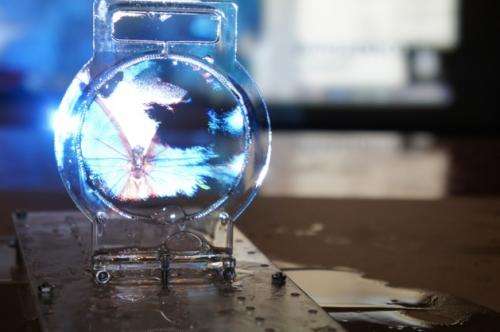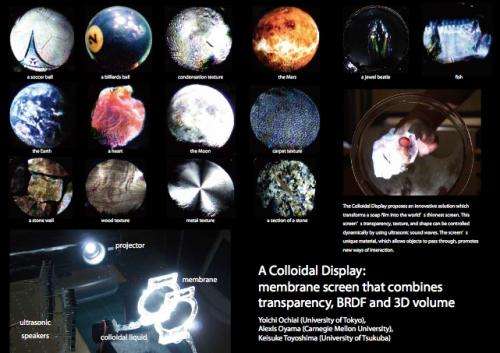(Phys.org) -- A team from three universities developed what they claim is the world’s thinnest screen from a bubble. They have figured out how to project images on soap film made of special properties and with a technique where images can run flat, textured, or even appear as if they were 3-D. They are using ultrasonic sound waves emitted from speakers to alter the surface. Also, they have found that by using a single projector, the texture of any image can be changed. An object such as a ball can be made to look smooth or rough. Their bubble is not the type of bubble waved away or popped by children at play.
They use a soap film made from a mixture of colloids that make the bubble hard to pop; in fact they explain that it is possible to poke the bubble screen and interact with it.
Describing their work, the team does acknowledge that research on dynamic BRDF displays have been done in the past. (BRDF stands for "Bidirectional Reflectance Distribution Function," a four-dimensional function that defines how light is reflected at an opaque surface.) “Their work stands out, they note, in their use of controlling the screen with ultrasonic vibrations.
They wrote about this in a report titled “A Colloidal Display: membrane screen that combines transparency, BRDF and 3D volume.” The authors are Yoichi Ochiai, University of Tokyo, Alexis Oyama, Carnegie Mellon University, and Keisuke Toyoshima, University of Tsukuba.
They point out that the ultrasonic waves and ultra thin membranes combined under their technique can render realistic, distinctive, and vivid on screen imagery.
The team is confident that their system can contribute to new and creative opportunities in display engineering and design. After all, interest is easily drawn in a bubble housing an image, where the bubble can be poked without breaking and which permits the person to interact with it, plus textures of images that can be changed on the fly. In the case of museums, it has been suggested that this bubble screen system could be used to display floating planets. There are numerous possibilities for displays for any exhibition events. While a single screen is enough to alter the texture of a 2-D image, multiple screens can be combined for a 3-D effect.
The system will be presented in August at Siggraph 2012, a conference on computer graphics and interactive techniques, in Los Angeles, from August 5 through August 9.
More information: 96ochiai.ws/colloidaldisplay
© 2012 Phys.Org























